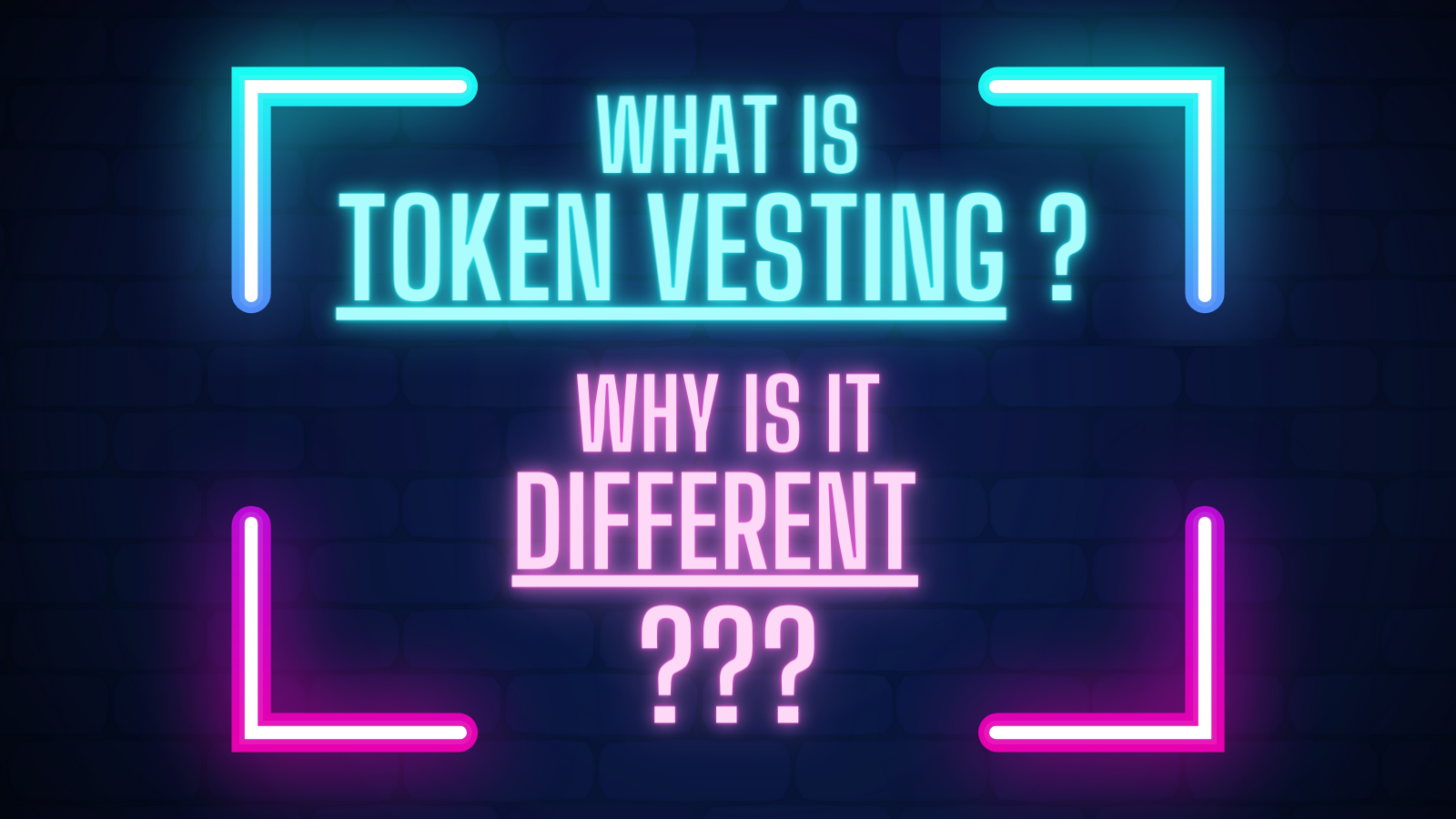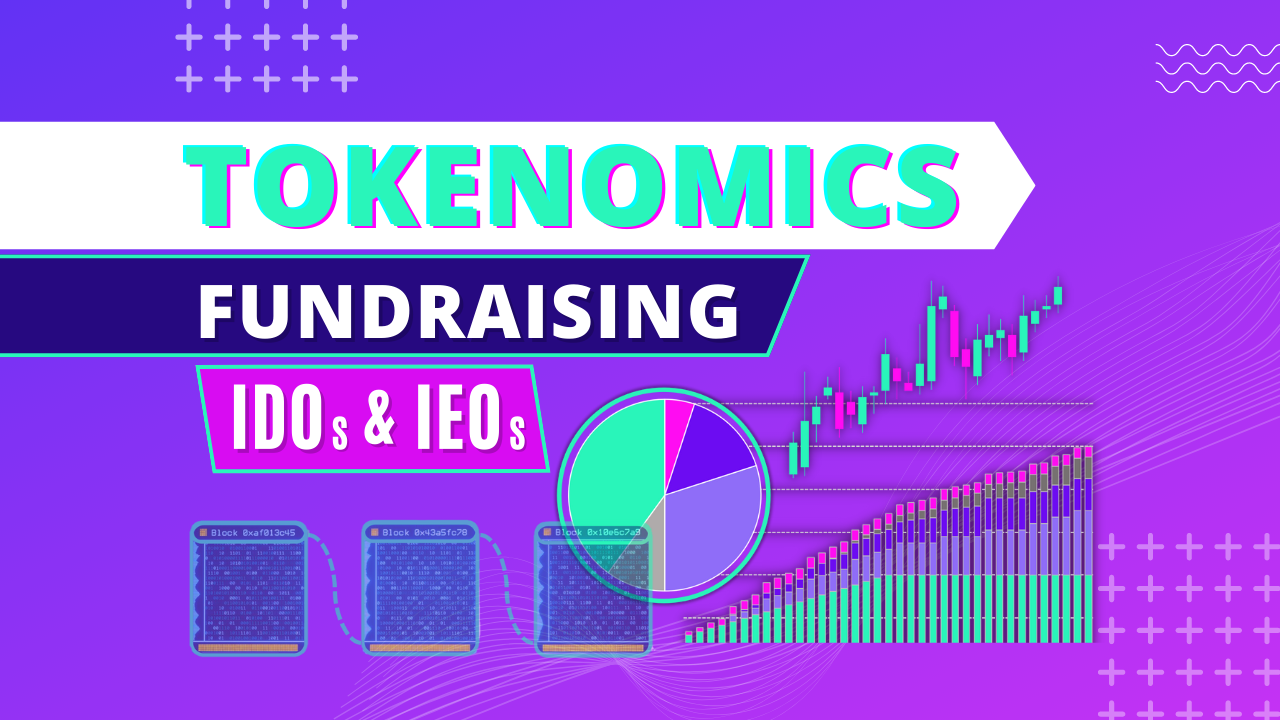
Learn more tokenomics
Watch video version of this article
Click to subscribe:
Previously...
...we looked at how token sales are structured, and highlighted how token vesting schedules make up one of the key components.
Vesting is nothing new.
We find it used in terms for familiar everyday contracts concerning retirement plans, inheritances, and employment compensation.
However, this familiarity makes it important for us to examine token vesting carefully. Because it turns out that vesting plays a very different role compared to the ones we're familiar with.
And these differences MATTER.
It's valuable to understand them properly to be able to understand what sets good token vesting terms apart from bad ones!
Same same... but different

Let's make a quick recap.
In traditional contracts, vesting is a legal term that defines when rights and interests over a property transfer over to a specified person.
This mechanism allows those transfers to take place at a different time from that upon which the contract is executed. For agreements that involve the transfer a collection of assets or quantity thereof, vesting terms allow us to transfer portions of that total gradually, over time.
The motivations for using vesting are rooted in simple, familiar intuitions that we have about fairness and risk.
If a transfer of assets is being offered in exchange for a future service that yet to be delivered, we know it may not be a good idea to transfer the full award upfront. Using vesting terms to defer the transfer allows us to check that the other party has made the contributions that we wish to procure with this exchange.
In 'economics speak', the vesting terms are being used as an incentive alignment mechanism.
With the right choice of terms and conditions, the receiving party is given an incentive to earn these rewards by taking actions that align with the interests of the awarding party.
So that's vesting as we already know it. Let's now look at it in a blockchain context.
Here, vesting does not necessarily have any legal status, but it performs the same basic action. It schedules a deferred transfer of tokenised assets into the control of a receiving party. Cryptographic protections native to the blockchain secure the transfer and control of these tokens in a manner that creates the same immediate, functional benefit as a legal transfer of ownership would.
These implementation details however, are not our main concern today. Rather, it is the different economic goals for which token vesting contracts are used in token contexts.
We shall see that token vesting is used as way of exercising:
- Monetary regulation
- Price discrimination
- Mitigation of adverse selection risks
- Public multi-sided incentive alignment
Let's explore these one at a time...
Monetary regulation
The token sale format was developed to raise funds from the presale of tokens that are going to perform a direct and active role within their native economies. (Equity, by contrast, is a purely financial instrument that does not play an active role in the economic process it is used to finance.)
The suitability of tokens to fulfil their active economic roles typically depends on their economic value. If tokens are valuable, users can receive token rewards that are economically meaningful, and are able to make token exchanges with others that are economically meaningful as well.
The economic value retained by tokens is strongly influenced by how many of them exist, in relation to the amount of value they provide tokenholders with access to.
This means that even if the token has NOT been specifically designed as a digital currency (or "cryptocurrency"), monetary considerations are still fundamental to good value design.
Any mechanism that significantly affects the supply of tokens available, will have monetary consequences that need to be evaluated.
This is clearly relevant to vesting contracts.
They set the earliest time at which tokens are available to be used by their recipients, and enter into active circulation (whether in exchange markets or the token economy).
Good value design for the project token should include an effort to set vesting terms to align growth in token supply with a growth the underlying value base that the tokens give bearers access to.
The monetary significance of token vesting schedules, also provides a clearer understanding of how vesting allows a project to leverage future expected value growth, to finance itself today.
Without vesting, a prudent project would have to be very conservative and only sell the small quantity of tokens that could initially circulate at a sustainable value. In this case, the project would have less value on hand to offer early contributors who could help make the project a success.
Vesting contracts allow a project to make offers that include tokens paid out from future token supply, increasing the value it has available to offer today. When designed well, recipients get a claim on anticipated future value growth, without compromising the monetary fundamentals needed to get there.
The priority of monetary policy

Clearly, the monetary significance of token vesting is novel and different to the vesting we've seen before.
But to understand its full implications, we also need to appreciate the importance of monetary effects on early-stage token economies.
Remember that a token's value is of fundamental importance.
This is what determines the token's capacity to fulfil its core economic role, and its ability to support a financial return for early investors. This makes monetary effects the DOMINANT concern when setting vesting schedules. Which means that...
token vesting contracts are — first and foremost — instruments of monetary policy
This matters, because it leads to different recommendations over how vesting is best used. Especially when compared to the familiar vesting use cases of simple incentive alignment, with no monetary effects or constraints.
A common mistake I have seen founders make in this regard, is to arrange token vesting schedules so that they concentrate a deferred award onto some future date. This structure is intended to give the deferred incentive extra psychological force, because that makes the first reward the recipient gets, a substantial one.
Unfortunately the monetary consequences this scheduling generates for a fledgling token economy, make it very risky.
These schedules increase the chance that circulating supply will change significantly, without any relation to matching changes in the underlying value base of the economy. Additionally, large token unlocks also invite strategic trading behaviours in exchange markets that increase exchange price volatility at the cost of economic users, potentially destabilising the core economy.
These are theoretically motivated arguments, but they have found some empirical support today.
Long and short of it, is that SMOOTHER vesting schedules are BETTER.
The monetary concerns around our vesting schedules trump any extra incentive benefits of offering concentrated rewards during a project's early stages.
Price discrimination

This term comes from microeconomics.
It refers to a set actions that firms can take to increase their revenues. Specifically, by charging different customer segments different prices for the same, or very similar items.
Vesting terms give projects another way of exercising price discrimination on their token offers.
Instead of being aimed at increasing revenues, they serve to improve the investment capital and talent that projects have access to.
So how does this work? 'Vesting terms' are not prices!
Yes, that's true... But vesting terms still have 'price-like' effects on perceived value, due to agents' "time preferences". (Also referred to as the "time value of money".)
This foundational characteristic of how we appraise value, means that an award that arrives later is less valuable to us than one that we get sooner, no matter what asset is involved.
This is commonly explained as a discounting of risk. Simply by being in the future, the receipt of any payment becomes less certain and therefore riskier.
In the current token context, the magnitude of this discounting is amplified further by token inflation risks. Let's quickly see why.
Suppose that a projects selects vesting schedules that put their token economies on course for an increasing token supply. This has been done to match expected growth in the underlying value base. But this balancing exercise is highly uncertain and difficult to achieve.
In the absence of any real operational data, it is reasonable to assume that over time there is an increasing chance of a mismatch between the quantity of tokens in circulation and the value base that backs them.
A key contributing factor here is that stakeholder 'good will', which often helps to support token valuations earlier on, is unlikely to be sustained without real tangible progress being made by the project.
These token-specific inflation risks make later token access even riskier and less valuable than tokens that are delivered earlier.
Linking this back to pricing discrimination, this information should make clear that vesting terms will have a strong impact on the perceived value proposition of a token offer.
This means that vesting terms effectively give projects a second pricing lever to pull on, and that they can used to apply price discrimination strategies to their token offers.
As an example, consider how price discrimination can be used to increase the amount of capital raised by a project at a given economic cost, by creating multiple offers that target investors with differing preferences.
Investor "A" might prefer to get their tokens sooner, and be willing to pay a higher price on the tokens for that privilege.
Investor "B", meanwhile, may be more price sensitive but less time sensitive, and be willing to wait a little longer to receive their tokens in exchange for getting a better price.
A price discrimination strategy using a mix different of token prices AND vesting terms, can allow a project can target both investors.
This allows the project to raise capital for both of them, while reducing the total quantity of tokens sold (by selling more expensive tokens to investor "A"), and reducing the near-term inflation risk for the sum raised (through the longer vesting terms sold to investor "B").
This also helps to explain why (unlike conventional equity fundraising) blockchain startups frequently have multiple investment rounds open at the same time.
It allows them to take advantage of price discrimination to expand the range of investors and contributors they can effectively target and bring on board.
Adverse selection risk

This term also comes from microeconomics.
It refers to the risk that a contract offer ends up attracting counterparties who are likelier to be of low value to the party making the offer.
The textbook example looks at how insurance contract offers may end up attracting individuals who know they are at greater risk of needing that insurance in the first place. This erodes the profitability of the insurer.
A similar adverse selection risk exists for projects looking for their first investors.
Tokens in these earliest round are typically offered at a greater dollar price discount. This helps make the offer more attractive and offers added compensation for the higher risk assumed by these investors coming in early.
However, these low price offers also mean that that larger numbers of token are being sold for capital. That makes these investors, and the actions they take more economically consequential.
It is important to do everything possible to select investors who are best capitalised and have the longest investment horizon possible. This maximises the chances that they will feel comfortable holding a liquid token position during periods of volatility, or through a highly uncertain development period.
From this perspective, we can appreciate that vesting terms have a role to play in mitigating such adverse selection risks.
By subjecting tokens with the highest investor price discounts to long-dated vesting schedules, these offers can be made unappealing to investors with shorter investment horizons and a lower tolerance for risk, thereby helping to exclude these sorts of investors from signing up to this round.
Public multi-sided incentive alignment

Finally, we are going to see that token vesting still helps us to align incentives — as in traditional use cases — but in a very different way.
In the examples we are most familiar with, vesting helps to align the incentives of an economic agent (a new worker hire, for example) with those of a principal (the management that's hiring).
Agreements like these are typically private, and bilateral... but token sale offers could not be any more different!
For a start, they are multi-sided.
Different types of contributors need to be brought on board who are jointly needed to make the project a success. This is complex for a number of reasons:
First, is that the key parties derive value from tokens that they are granted in different ways, and so have differing objectives over how they use their tokens. Furthermore, the value-seeking actions of one group may disadvantage or interfere with the token benefits that can be accessed by the others.
Consider a project with the following three token stakeholder groups as an example:
- Investors want to sell the token in exchanges to generate a financial return on their initial investment, which depresses the price of the token
- Users want to use the token for the utilities it gives them access to within the native token economy, and are typically negatively affected by sell pressure in exchange markets
- Treasury administrators want to manage the token price to maximise the performance and sustainability of the platform as a whole, which may require them to take actions that do not fully align with short term interests of investors or users
What complicates matters further still, is that all the vesting offers made to any party, are visible to everyone else!
This is due to the inherent transparency of the smart contracts that are used to specify the terms of the deal and to execute them.
Things are made a little less complex in practice by the fact that bargaining power between the different parties is seldom evenly balanced. Nevertheless, negotiations for these agreements still face a real and significant constraint, of having to appear reasonably acceptable to all parties, in full view of everyone else.
In this context, vesting terms help to manage and control the interests of different stakeholder groups, and provide each of them with assurance that they are not being systemically disadvantaged, and that others are not receiving unfair or excessive rewards for the contributions that they make to the project.
In other words, a successful set of token vesting offers has to give everyone involved an acceptable, reasonable answer to the following question:
"Who gets what? When? And Why?"
As you might imagine, this multi-sided interplay makes for some very dynamic negotiations on the way to securing a fundraise and initial listing! Changes made to token allocation and vesting terms along the way, need to be cross-checked for the impacts they have on other stakeholder parties before they are agreed. (That's why I made applied exercises that practice how to handle these situations a crucial part of my teaching course!)
Summary and recap
Token vesting at first glance looks like a simple, and straight forward mechanism. A closer look however, reveals it is deployed to serve multiple ends at the same time.
We saw, in particular, that token vesting contracts help us to perform:
- Monetary regulation
- Price discrimination
- Mitigation of adverse selection risks
- Public multi-sided incentive alignment
Among these, we saw that monetary considerations are of prime importance. This owes to the impact they have on fundamental concerns about the token's value, especially in the earliest stages of a project's development. This effectively makes vesting terms instruments of monetary policy first, and constrains how vesting is applied to meet other ends.
The other most significant feature of these contracts, is that offers to all parties are public and need some degree of shared buy in, in order for the project to proceed.
Altogether these factors make token vest scheduling a much richer, complex, and nuanced than familiar vesting applications would have us expect. Setting good vesting terms requires an understanding of stakeholders involved and the nuances that are in play in a given negotiation situation.
Next time...
... we'll see that despite all this complexity, our main concerns can be handled by using vesting contracts that are defined with just THREE PARAMETERS!
(And that's a great advantage, because it helps simplify communications and analysis for all the parties involved...!)
Weighing it all up
So now that we understand the parts of a token sale offer and their economic function... how do we make sense of making out whether they are good or bad?
[complex topic check out my own course...]
mention smart contracts and trust...??
But what we can say here... in non-technical terms, a good token sale offer needs to give a reasonable answer to a reasonable question about these new tokens:
A rough guide to a good response, is that it should offer a strong case to explain that:
"Who gets what? When? And Why?"
So
So yes, developers can use their powers to achieve much more than has previously been possible through an early-stage equity financing... But they CAN'T stretch those powers out without limit!
The short answer is that WE do...!
"We"... as prospective investors and users of the token in the sale proposal.
The rules that govern the token's economic attributes are defined and executed on immutable smart contracts deployed on a public blockchain.
These contracts are fully transparent and auditable, and the offer truthful statements about the smart contract's code will execute.
This means we can check the contract to decide for ourselves whether the numbers "add up"...!
And many times they won't.
The guide for a good response, is that it should make a strong case that:
- Tokens are distributed to agents who have contributed value to the economic process that the token supports
- The increase in supply arising from the tokens they are granted does not outstrip or disrupt the ability of the token economy to continue driving a sustainable flow of value

Roderick is a blockchain professional, specialising in tokenomics advisory and economic design.
His advisory contributions have helped raise over $100m for blockchain startups, and he brings over 10 years of prior quantitative modelling, financial analysis, and transaction experience to his work.
He resources the innovative thinking needed for this emerging field with strong academic foundations that include a MSc. in Economic Policy from UCL, and the CFA Charter.
Roderick is inspired by the potential he sees for blockchain technology to address old, long-standing economic issues that many students are still being taught are impossible be solve.
A life-long learner, he eagerly participates in knowledge building by sharing his expertise through open blog and video content, and by offering specialised training courses to help aspiring professionals start out and advance in this field.


